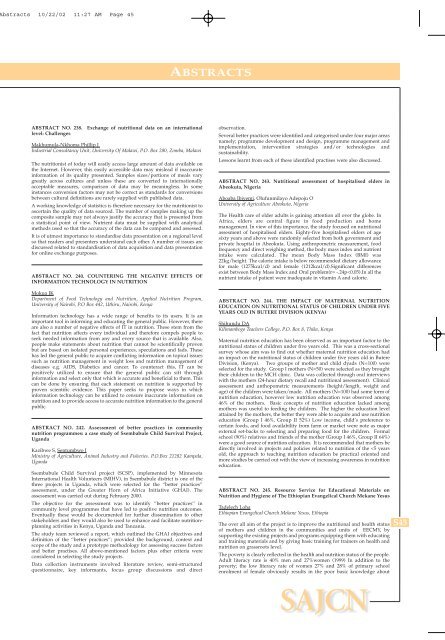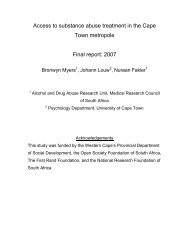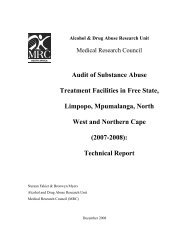Pan-African Conference 21 - 24 July 2002 Inter-Continental Hotel ...
Pan-African Conference 21 - 24 July 2002 Inter-Continental Hotel ...
Pan-African Conference 21 - 24 July 2002 Inter-Continental Hotel ...
You also want an ePaper? Increase the reach of your titles
YUMPU automatically turns print PDFs into web optimized ePapers that Google loves.
Abstracts 10/22/02 11:27 AM Page 45<br />
ABSTRACT NO. 238. Exchange of nutritional data on an international<br />
level: Challenges<br />
Makhumula-Nkhoma Phillip J<br />
Industrial Consultancy Unit, University Of Malawi, P.O. Box 280, Zomba, Malawi<br />
The nutritionist of today will easily access large amount of data available on<br />
the <strong>Inter</strong>net. However, this easily accessible data may mislead if inaccurate<br />
information of its quality presented. Samples sizes/portions of meals vary<br />
greatly across cultures and unless these are converted to internationally<br />
acceptable measures, comparison of data may be meaningless. In some<br />
instances conversion factors may not be correct as standards for conversions<br />
between cultural definitions are rarely supplied with published data.<br />
A working knowledge of statistics is therefore necessary for the nutritionist to<br />
ascertain the quality of data sourced. The number of samples making up the<br />
composite sample may not always justify the accuracy that is presented from<br />
a statistical point of view. Nutrient data must be supplied with analytical<br />
methods used so that the accuracy of the data can be compared and assessed.<br />
It is of utmost importance to standardise data presentation on a regional level<br />
so that readers and presenters understand each other. A number of issues are<br />
discussed related to standardisation of data acquisition and data presentation<br />
for online exchange purposes.<br />
ABSTRACT NO. <strong>24</strong>0. COUNTERING THE NEGATIVE EFFECTS OF<br />
INFORMATION TECHNOLOGY IN NUTRITION<br />
Mokua JK<br />
Department of Food Technology and Nutrition, Applied Nutrition Program,<br />
University of Nairobi, P.O Box 442, Uthiru, Nairobi, Kenya<br />
Information technology has a wide range of benefits to its users. It is an<br />
important tool in informing and educating the general public. However, there<br />
are also a number of negative effects of IT in nutrition. These stem from the<br />
fact that nutrition affects every individual and therefore compels people to<br />
seek needed information from any and every source that is available. Also,<br />
people make statements about nutrition that cannot be scientifically proven<br />
but are based on isolated personal experiences, speculations and fads. These<br />
has led the general public to acquire conflicting information on topical issues<br />
such as nutrition management in weight loss and nutrition management of<br />
diseases e.g. AIDS, Diabetics and cancer. To counteract this, IT can be<br />
positively utilized to ensure that the general public can sift through<br />
information and select only that which is accurate and beneficial to them. This<br />
can be done by ensuring that each statement on nutrition is supported by<br />
proven scientific evidence. This paper seeks to propose ways in which<br />
information technology can be utilized to censure inaccurate information on<br />
nutrition and to provide access to accurate nutrition information to the general<br />
public.<br />
ABSTRACT NO. <strong>24</strong>2. Assessment of better practices in community<br />
nutrition programmes: a case study of Ssembabule Child Survival Project,<br />
Uganda<br />
Kazibwe S, Sentumbwe J<br />
Ministry of Agriculture, Animal Industry and Fisheries. P.O.Box <strong>21</strong>282 Kampala,<br />
Uganda<br />
Ssembabule Child Survival project (SCSP), implemented by Minnesota<br />
<strong>Inter</strong>national Health Volunteers (MIHV), in Ssembabule district is one of the<br />
three projects in Uganda, which were selected for the ‘’better practices’’<br />
assessment, under the Greater Horn of Africa Initiative (GHAI). The<br />
assessment was carried out during February 2000.<br />
The objective for the assessment was to identify ‘’better practices’’ in<br />
community level programmes that have led to positive nutrition outcomes.<br />
Eventually these would be documented for further dissemination to other<br />
stakeholders and they would also be used to enhance and facilitate nutritionplanning<br />
activities in Kenya, Uganda and Tanzania.<br />
The study team reviewed a report, which outlined the GHAI objectives and<br />
definition of the ‘’better practices’’; provided the background, context and<br />
scope of the study and a prototype methodology for assessing success factors<br />
and better practises. All above-mentioned factors plus other criteria were<br />
considered in selecting the study projects.<br />
Data collection instruments involved literature review, semi-structured<br />
questionnaire, key informants, focus group discussions and direct<br />
ABSTRACTS<br />
observation.<br />
Several better practices were identified and categorised under four major areas<br />
namely; programme development and design, programme management and<br />
implementation, intervention strategies and/or technologies and<br />
sustainability.<br />
Lessons learnt from each of these identified practises were also discussed.<br />
ABSTRACT NO. <strong>24</strong>3. Nutritional assessment of hospitalised elders in<br />
Abeokuta, Nigeria<br />
Aboaba Ibiyemi, Olufunmilayo Adepoju O<br />
University of Agriculture Abeokuta, Nigeria<br />
The Health care of older adults is gaining attention all over the globe. In<br />
Africa, elders are central figure in food production and home<br />
management. In view of this importance, the study focused on nutritional<br />
assesment of hospitalised elders. Eighty-five hospitalised elders of age<br />
sixty years and above were randomly selected from both government and<br />
private hospital in Abeokuta. Using anthropometric measurement, food<br />
frequency and direct weighing method, the body mass index and nutrient<br />
intake were calculated. The mean Body Mass Index (BMI) was<br />
22kg/height. The calorie intake is below recommended dietary allowance<br />
for male (1275kcal/d) and female (1<strong>21</strong>2kcal/d).Significant differences<br />
exist between Body Mass Index and Oral problem(r= -.<strong>24</strong>p

















